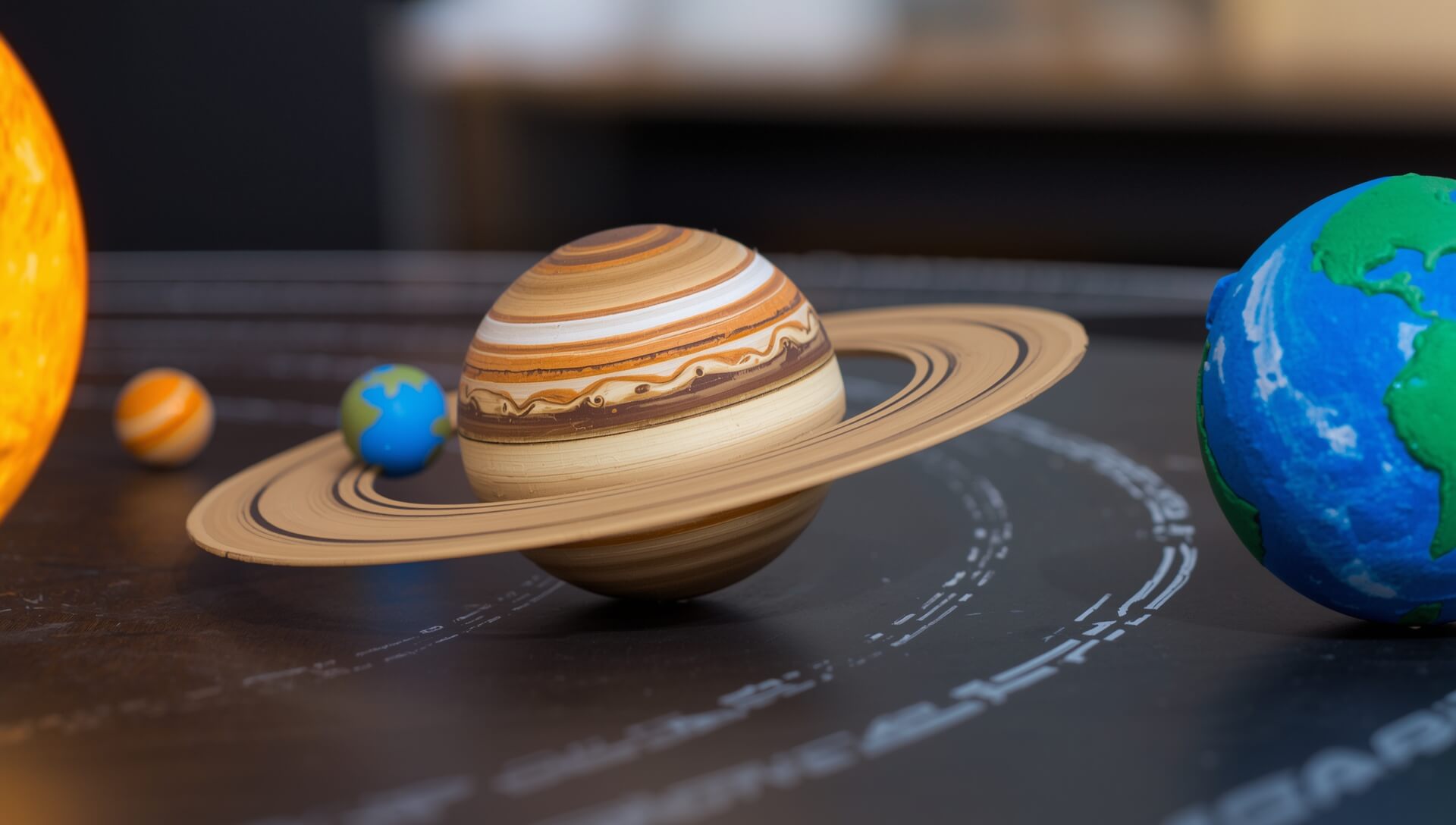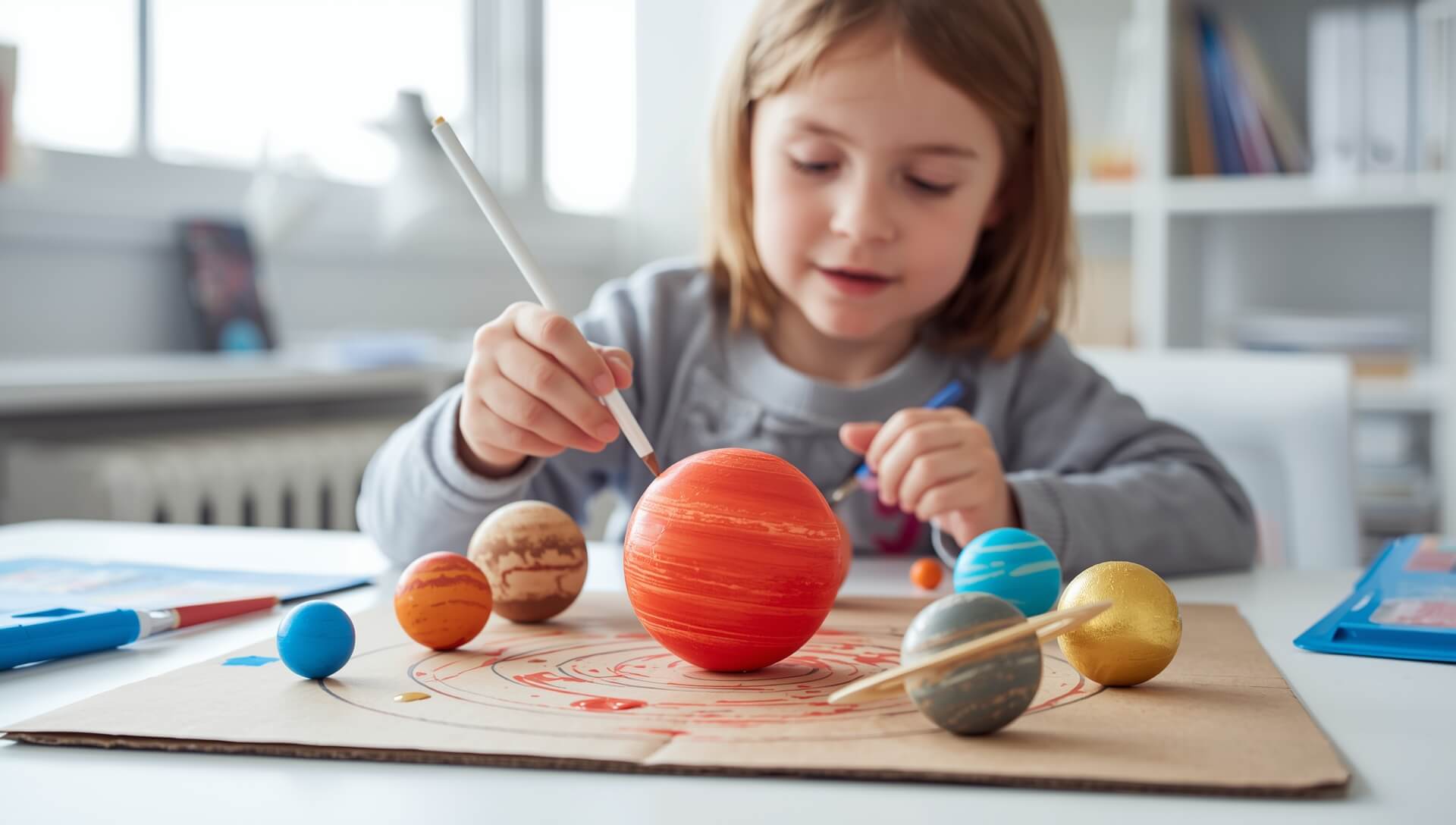Solar system project ideas have always fascinated young learners, especially when they can transform science into something they can see and touch. Imagine your child building planets, painting them with bright colors, and arranging them in perfect circles as they learn the planets in order from the sun. It’s not just a craft—it’s a journey through space that sparks creativity and curiosity at the same time. By creating a 3D planet model, children can explore the wonders of astronomy while enjoying a hands-on, exciting learning experience.
This kind of educational science activity turns a simple classroom task into an unforgettable memory. When kids work on a DIY solar system craft, they are not just learning facts—they are creating something that makes science feel real and alive. A project like this makes complex ideas simple, fun, and engaging, giving children the chance to learn, imagine, and dream big.
Why Do a Solar System Project?
A solar system project is more than just a fun craft. It is an educational science activity that teaches children how planets move, their varying sizes, and why they orbit the sun. Kids learn concepts like gravity, rotation, and planetary order while staying engaged with hands-on work.
Teachers often recommend these projects because they inspire creativity. A kids’ science fair project built around planets not only makes a strong display but also strengthens problem-solving and teamwork. Children who work on a solar system for kids’ activities often retain scientific facts better than through textbook reading.
Best Solar System Project Ideas for Kids
There are many solar system project ideas that children can try at home or in school. One popular approach is using a foam ball set to create planets and arranging them in the correct planets in order from the sun. Another idea is to design a rotating planet model with cardboard and wires to show orbital motion.
Kids also enjoy cardboard craft ideas like making a hanging mobile of planets. Younger children can focus on colorful painting and textures, while older students can include details such as rings, moons, and labels. These fun science projects for 5th graders mix creativity with real astronomy learning.
Step-by-Step 3D Solar System Project Guide
Making a 3D solar system model requires basic items such as paint, glue, cardboard, and foam balls. First, collect the materials for projects on the solar system, including string or wire to suspend planets. Next, paint the spheres according to their colors: Earth with blue and green, Mars with red tones, and Saturn with its golden rings.
The step-by-step solar system model guide continues with arranging the planets. Mercury, Venus, Earth, Mars, Jupiter, Saturn, Uranus, and Neptune should be arranged in the proper order. To highlight realism, show planet size comparison with Jupiter larger and Mercury smaller. This approach makes the model a mix of art and science.

Fun Solar System Projects for School
In classrooms, solar system projects often stand out at science fairs. Teachers encourage simple astronomy projects because they let children learn complex facts in playful ways. A painted shoebox diorama can display planets with glowing stars, giving kids pride in presenting their work.
Another approach is building a rotating planet model that turns with a small motor. This project explains how planets move around the sun, which many students find fascinating. Such educational science activity options not only engage the class but also impress judges at school events.
Creative Solar System Project Ideas for Beginners
Beginners may prefer an easy solar system project for kids that uses common household items. Paper plates can represent planets, strung together with yarn to form a hanging solar system mobile. Children can also use clay to shape miniature planets and arrange them on cardboard.
Parents who want to try DIY solar system craft methods can guide children to draw the sun and planets, then color them with crayons. By starting with simple astronomy projects, children develop confidence before moving on to more advanced builds.
Hands-On Solar System Activities for Kids
The best way to learn science is through hands-on learning activities. Kids can try experiments like measuring distances between planets using scaled strings. This makes them visualize the vastness of space. Another engaging task is using flashlights to show how the sun gives light and shadows to planets.
These solar systems for kids activities not only boost curiosity but also support visual memory. When children connect models with real-world concepts, they develop stronger understanding. This makes every space project for school more meaningful.
Unique Features of the Planets to Add to Your Solar System Model
Adding unique features of planets makes projects stand out. Saturn’s rings can be built from thin cardboard. Jupiter’s storm can be painted as a red spot. Uranus’ distinctive rotation can be seen by tilting it on its side. Such details help explain why each planet is special.
The table below shows quick facts kids can include in their models:
| Planet | Unique Feature Example |
| Mercury | Smallest, closest to Sun |
| Venus | Thick clouds, hottest planet |
| Earth | Only planet with life |
| Mars | Red dust, volcanoes |
| Jupiter | Largest, Great Red Spot |
| Saturn | Wide rings |
| Uranus | Tilted sideways |
| Neptune | Strong winds |
By focusing on planet size comparison and surface features, children make science more engaging.
Sustainable Solar System Craft Ideas
Parents and teachers can encourage sustainable craft ideas for kids by reusing old materials. Bottle caps, cardboard boxes, and scrap paper can be shaped into planets. This reduces waste and teaches eco-friendly habits.
A DIY solar system craft using recycled items also costs less. It is not only a fun family project but also a way to practice environmental responsibility. Kids who create a solar system project this way learn science and sustainability together.
Next-Level Solar System Project Ideas for Older Students
Older students can take projects on the solar system to the next stage by adding movement and technology. A motorized rotating planet model can show orbital paths. Students can even add LED lights to the sun for a glowing effect.
Some create digital models with software, combining coding and astronomy. This takes a kids’ science fair project beyond crafts into engineering. Such hands-on learning activities help them think critically and prepare for future STEM careers.
Conclusion: Making Solar System Projects Fun and Educational
A project on the solar system is more than paint and cardboard. It is a journey into science that makes astronomy real for children. Whether it’s an easy solar system model for kids or an advanced motorized display, each design teaches important lessons about space.
Teachers, parents, and students can all benefit from these educational science activity experiences. From simple astronomy projects to creative designs, children learn teamwork, patience, and scientific thinking. As one teacher shared, “When kids build the solar system, they build confidence too.” To explore more astronomy resources, check out NASA’s Solar System Exploration , National Geographic Kids Space and Go Techanic.
FAQs:
- What’s the best way to create projects on the solar system?
Projects on the solar system can be made by designing planet models, painting them, and arranging them around the sun. - What are projects on the solar system?
It is a creative model that shows all the planets, the sun, and their positions, helping kids understand space better. - What materials are required for projects on the solar system?
Basic items include cardboard, foam balls, paint, glue, and string to represent planets and their orbits. - How simple is it to build a solar system for children?
Use simple materials like paper, cardboard, or clay to design colorful planets in the correct order. - What value do projects on the solar system bring to children?
It helps children learn science in a fun way, improves creativity, and makes astronomy easy to understand.


